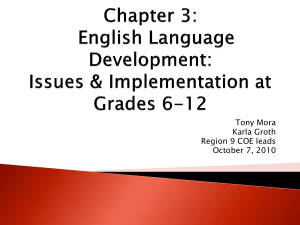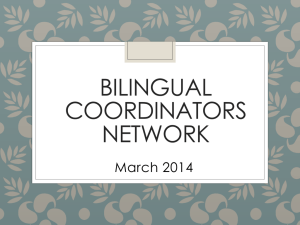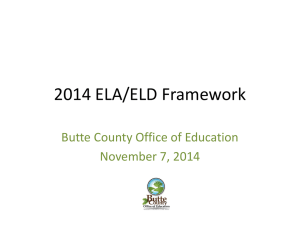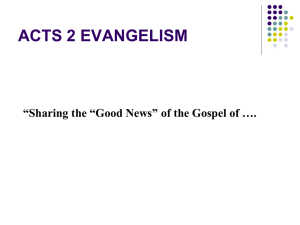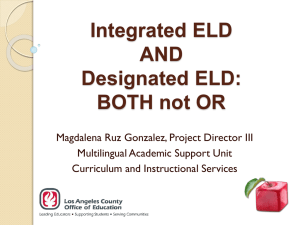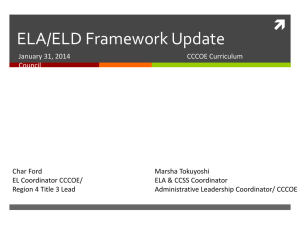Chapter 6-Connecting Content & Language
advertisement
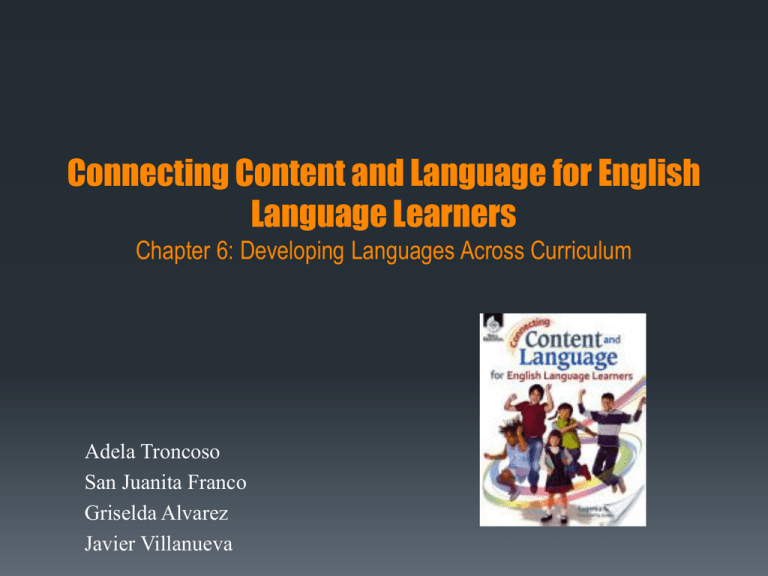
Connecting Content and Language for English Language Learners Chapter 6: Developing Languages Across Curriculum Adela Troncoso San Juanita Franco Griselda Alvarez Javier Villanueva “English Language Development is part of a student’s entire day as he or she tries to make sense of spoken language, written language, complex content vocabulary and concrete and abstract concepts.” (Mora-Flores, 2011,123) There exists lots of confusion around the definition and purpose of the following: 1. English Language Development (ELD), 2. Content ELD, and 3. Academic Language Development (ALD) 1. English Language Development (ELD) NOTE: ELD/ESL are used synonymously depending on where and the level you teach. “The purpose of ELD/ESL is to enable English Language Learners to master the skills of listening, speaking, reading, and writing in English to the extent that they are able to use the English language appropriately and effectively for authentic communicative purposes and to achieve academic success in English-Language mainstreamed classrooms” (Wright 2010,82) Time and Grouping for ELD ELD times vary from state to state and district to district, from 35 min. in kindergarten to an hour in grades 1st-5th. Some school districts provide ELD instruction to a mixed group of ELL’s. Other districts cluster students based on their ELD level. Eugenia Mora-Flores, author of this book, has found that clustering students during ELD to be most effective, but only when ELL’s are mixed throughout the rest of their instructional day. ELD Instruction What happens during ELD varies greatly. What we know is that students must receive explicit instruction in: • Academic vocabulary • Functions and forms • Opportunities to develop Oral Fluency • Opportunities to develop Written Fluency. Grammar, reading comprehension and writing development are also a large part of ELD instruction. ELD Framework • ELD Framework was developed by Dr. D. Beltran and Dr. L. Sarmiento in 2010. • It is based on three overlapping and interacting dimensions: talk, thought, and interaction. • This framework guides teachers as they think about “how” to implement lessons that can effectively develop academic English. Every lesson is designed to support English Language Learners and must include talk, thought, and interaction. Talk Students need opportunities to engage in oral discourse. They need to hear language models and use language themselves to develop oral fluency. Providing students with engaging activities across the curriculum where they can share their thinking and learning with one another exposes them to academic language. They hear what it sounds like to use language for a variety of purposes and hear vocabulary used in context. Thought The connection between language and thought is evident when students are provided opportunities to develop high levels of cognition, engage in critical thinking, and share their thinking with one another. The thinking we require of students leads to the talk that they will use to share their thinking. Interaction The dialogic and mediated exchanges between users of a language create authentic opportunities to acquire language. Social interaction plays an important role in second-language acquisition, including exchanges between teacher and student and between students. Strategies for Teaching ELD - Tea Party - Travelers and Talkers - Lines of Communication - World in a Bag - Four-Corner Literature Review 2. Content ELD Content ELD focuses on the development of English with clear language objectives, but is taught within a content area. Language and content must balance each other out in order for students to excel academically and acquire Content ELD. Content Language • A content ELD approach supports English Language Learners by providing a meaningful context within which students can develop English. • Content ELD is intentional, explicit language objectives and has many opportunities for students to use English orally and in writing. • Content ELD can become your Science or Social Studies time of day as well, therefore, it must also contain clear content and measurable objectives with ample opportunities to explore, understand and make meaning from content. 3. Academic Language Development (ALD) • The difference between ELD and ALD is the focus on teaching content, while making language development a by-product. • Critical to ALD is that teachers provide comprehensible input to support students’ content knowledge and provide opportunities for guided comprehensible output. Conclusion ELL’s are exposed to complex language throughout the school day. ELL’s need ongoing support to make meaning when they encounter language used for a variety of purposes. Teachers must understand what it means to teach language and through language. This includes knowledge of ELD, Content ELD, and ALD.
